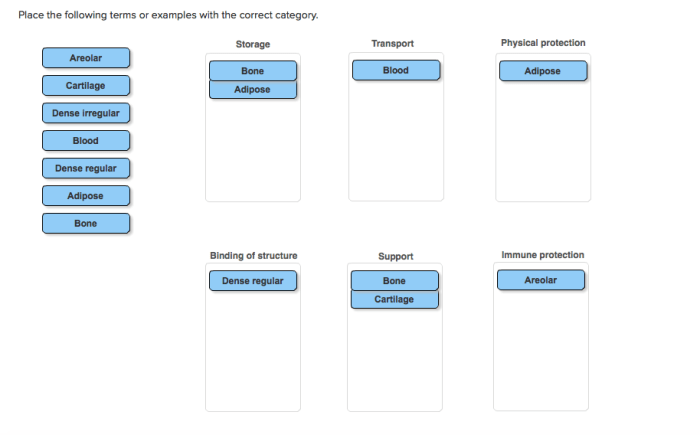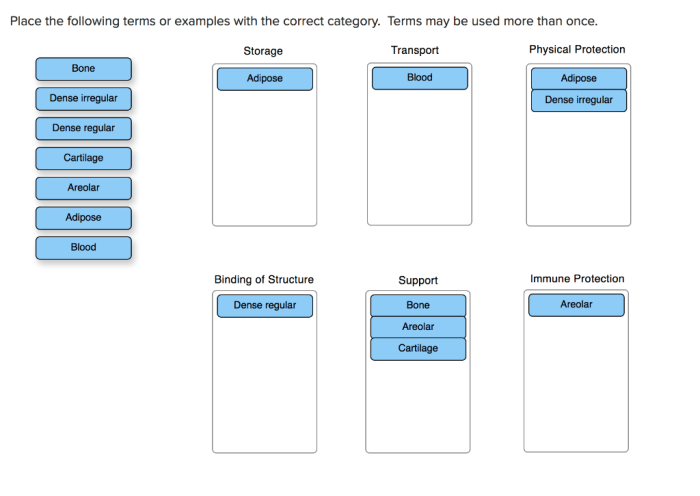Place the following terms or examples with the correct category. This is a fundamental task in many fields, from science and education to business and everyday life. By understanding the principles of categorization, we can improve our communication, understanding, and decision-making.
This guide will provide an overview of the different categories of terms and examples, the criteria used for categorization, and the methods used to categorize them. We will also discuss the benefits and challenges of categorization, and provide examples of how it has been used in practice.
Categories of Terms and Examples

Terms and examples can be categorized into different groups based on their characteristics or properties. This helps in organizing and understanding the information effectively.
Some common categories include:
- Concrete terms:These are terms that refer to physical objects or tangible entities, such as “table,” “book,” or “car.”
- Abstract terms:These are terms that refer to intangible concepts or ideas, such as “love,” “justice,” or “freedom.”
- General terms:These are terms that refer to a broad category of things, such as “animal,” “plant,” or “fruit.”
- Specific terms:These are terms that refer to a particular instance of a category, such as “dog,” “rose,” or “apple.”
- Positive terms:These are terms that have a positive connotation, such as “happy,” “beautiful,” or “successful.”
- Negative terms:These are terms that have a negative connotation, such as “sad,” “ugly,” or “unsuccessful.”
Criteria for Categorization

The criteria used to categorize terms or examples can vary depending on the context and purpose of the categorization.
Some common criteria include:
- Semantic similarity:This criterion groups terms or examples that have similar meanings.
- Syntactic similarity:This criterion groups terms or examples that have similar grammatical properties, such as part of speech or sentence structure.
- Pragmatic similarity:This criterion groups terms or examples that are used in similar contexts or for similar purposes.
- Historical similarity:This criterion groups terms or examples that have a shared history or origin.
- Cultural similarity:This criterion groups terms or examples that are specific to a particular culture or society.
Methods for Categorization
There are different methods that can be used to categorize terms or examples.
Some common methods include:
- Manual categorization:This method involves manually assigning terms or examples to categories based on the criteria chosen.
- Automatic categorization:This method uses computer algorithms to assign terms or examples to categories based on predefined rules or machine learning techniques.
- Hierarchical categorization:This method organizes terms or examples into a hierarchical structure, where each category can have subcategories.
- Faceted categorization:This method uses multiple dimensions or facets to categorize terms or examples, allowing for more flexible and nuanced categorization.
Benefits of Categorization: Place The Following Terms Or Examples With The Correct Category
Categorization offers several benefits for organizing and understanding information:
- Improved communication:Categorization helps to ensure that terms and examples are used consistently and clearly, reducing ambiguity and misunderstandings.
- Enhanced understanding:Categorization allows for the identification of patterns and relationships between terms or examples, leading to a deeper understanding of the subject matter.
- Efficient decision-making:Categorization enables the grouping of similar terms or examples, making it easier to compare and contrast options and make informed decisions.
- Knowledge organization:Categorization helps to organize and structure knowledge, making it easier to retrieve and access relevant information.
Challenges of Categorization

While categorization offers many benefits, it also presents certain challenges:
- Overlapping categories:Some terms or examples may fit into multiple categories, leading to ambiguity and potential inconsistencies.
- Subjectivity:The criteria used for categorization can be subjective, leading to different interpretations and categorizations.
- Evolving knowledge:As knowledge evolves, the categories used for categorization may need to be updated or revised to reflect new information and understanding.
- Computational complexity:Automatic categorization can be computationally complex, especially for large datasets.
Examples of Categorization in Practice
Categorization has been widely used in various fields, including:
- Science:Categorization is used to classify organisms, chemical elements, and other scientific entities based on their characteristics and properties.
- Education:Categorization is used to organize educational materials and resources into subject areas, grade levels, and learning objectives.
- Business:Categorization is used to organize products, services, and customers into different groups based on their attributes, preferences, and behaviors.
General Inquiries
What is the purpose of categorization?
Categorization helps us to organize and understand the world around us. By grouping similar things together, we can more easily identify patterns and relationships.
What are the different types of categories?
There are many different types of categories, but some common types include: hierarchical categories, which are organized in a tree-like structure; flat categories, which are not organized in a hierarchy; and dynamic categories, which can change over time.
How do I choose the right category for a term or example?
The best way to choose the right category for a term or example is to consider the purpose of the categorization. What do you want to achieve by categorizing the term or example?